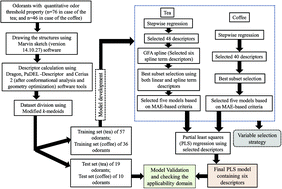PLS regression-based chemometric modeling of odorant properties of diverse chemical constituents of black tea and coffee†
Abstract
Tea and coffee are the most attractive non-alcoholic beverages used worldwide due to the odorant properties of diverse components present in these beverages. The aim of this work is to investigate the key structural features which regulate the odorant properties of constituents present in black tea and coffee using regression-based chemometric models. We have also investigated the key structural properties which create the odor difference between tea and coffee. We have employed different variable selection strategies to extract the most relevant variables prior to development of final partial least squares (PLS) models. The models were extensively validated using different validation metrics, and the results justify the reliability and usefulness of the developed predictive PLS models. The best PLS model captured the necessary structural information on relative hydrophobic surface area, heteroatoms with higher number of multiple bonds, hydrogen atoms connected to C3(sp3)/C2(sp2)/C3(sp2)/C3(sp) fragments, electron-richness, C–O atom pairs at the topological distance 10 and surface weighted charged partial negative surface areas for explaining the odorant properties of the constituents present in black tea. On the other hand, C–S atom pairs at the topological distance 1, C–C atom pairs at the topological distance 5, donor atoms like N and O for hydrogen bonds, hydrogen atoms connected to C3(sp3)/C2(sp2)/C3(sp2)/C3(sp) fragments and R–CX–X fragments (where, R represents any group linked through carbon and X represents any heteroatom (O, N, S, P, Se, and halogens)) are the key structural components captured by the PLS model developed from the constituents present in coffee. The developed models can thus be successfully utilized for in silico prediction of odorant properties of diverse classes of compounds and exploration of the structural information which creates the odor difference between black tea and coffee.



 Please wait while we load your content...
Please wait while we load your content...